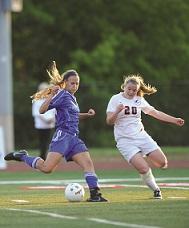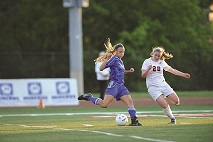
 The National Federation of State High School Associations (NFHS) follows what’s happening in high school sports. In fact, the Athletics Participation Survey, compiled annually using figures provided by our 51 member state high school associations, gives a very clear snapshot of how many kids are participating, and in which sports.
The National Federation of State High School Associations (NFHS) follows what’s happening in high school sports. In fact, the Athletics Participation Survey, compiled annually using figures provided by our 51 member state high school associations, gives a very clear snapshot of how many kids are participating, and in which sports.
To give a brief background, high school sports are as popular as they have ever been. In fact, during the most recent school year (2012-13), participation in high school sports increased for the 24th straight year, passing the 7.7 million mark for the first time. A total of 7,713,577 students – an increase of 21,057 over the previous school year – participated in their school sports programs. The survey also provides insight into the numbers of boys and girls participating, in how many schools, in which sports and in which states.
Some sports have been popular for many years. For boys, football track, basketball, baseball and soccer are the top five sports. Among girls, track, basketball, volleyball, soccer and softball are the most popular.
Something we do notice are trends in sports: what is up, what is down and – this is especially interesting to us – what is new. The survey is a great place to see that growth at the national level.
 What Defines an Emerging Sport?
What Defines an Emerging Sport?
The NFHS doesn’t actually have a hard and fast policy about what constitutes an emerging sport. When a new sport begins to see sudden and annual increases in participation over the course of several years, that generally indicates an emerging sport. Interest in a sport may start in one state and begin to build across the country. We’ve seen that recently with bass fishing. Illinois started it; now Kentucky, Missouri and New Hampshire have followed.
Different Sports for Different Students
Something that often drives participation in new and different sports is the varying abilities or interests of students. Some students may not be a fit for the traditional sports of football, basketball, baseball, soccer, etc., either from a size or skill standpoint, but they may be interested in being a part of a competitive team.
This has happened with the growth of bowling. Students participating in bowling generally are a new group of students – they aren’t multiple-sport participants for the most part. We sometimes see a spike in some sports, such as swimming, during Olympic years, so seeing people have success in sport could be a factor as well.
 What Makes A Sport Grow?
What Makes A Sport Grow?
Some sports are expanding very quickly. Lacrosse is just outside the top 10 in both girls’ and boys’ participation and continues to grow. Fifteen years ago, nine states sponsored state championships in boys’ and girls’ lacrosse; today, 20 states have state championships. Lacrosse started as a regional sport in the East and has slowly spread across the country. While the predominant participation is still east of the Mississippi, states like California and Colorado, for example, have significant numbers. Bowling is another sport that continues to grow. Fifteen years ago, five states held a state championship in bowling; today, 18 states have a state championship. We think bowling will continue to grow because, as previously noted, it can attract a whole new group of students who aren’t currently involved in other sports.
Sometimes, growth in sports is fueled by students seeing it and wanting to play it. As far as lacrosse is concerned, for example, it may be a matter of more people becoming aware of the sport as it has moved from east to west across the country.
Whether a sport grows nationally also can have a lot to do with the region and the climate. For example, sand volleyball probably is going to have appeal in certain states and probably not in others. (At the moment, NFHS only recognizes volleyball as a whole; we have not broken it down into indoor and sand volleyball). At the national level, we would respond if growth began to occur in a number of states. From a climate standpoint, though, it’s hard to imagine sand or beach volleyball garnering as much interest as the traditional indoor fall sport across the country.
Accessibility: Unified and Adaptive Sports
This area of participation has the potential to have the greatest increase over the next few years and, obviously, to involve a whole new group of students. Although some states already were involved in these programs before the recent Department of Education ruling, there will be more and more involvement in the years to come.
There are two types of programs currently – Adaptive sports, where students with disabilities play the sport in a similar manner to the sport played by able-bodied participants, and Unified sports, which is a Special Olympics program which pairs a special-needs athlete with a peer without a disability. Currently, there are eight states with Adaptive programs and five with Unified programs; 15 years ago, there were only two states involved in these programs. Therefore, this area certainly will continue to grow.
 The Upward Spiral: Sports as a Whole
The Upward Spiral: Sports as a Whole
In our opinion, there are many and varied reasons for the continued growth of high school sports. First, a majority of kids like to be active and like to compete. They also like to be a part of a team. The number-one reason that is always reported on surveys is they participate in sports because they are fun.
Sports also help kids to feel a sense of accomplishment, which can improve self-esteem. Some participate in sports because it may be the only positive thing in their life. There are many reasons which all add up to a continued increase in participation.
We are sometimes asked whether the anti-obesity concerns of our society play into the growth of sports. To this point, I’m not sure that has contributed much to kids’ participation in varsity-level team sports at the high school level, but it could be a factor in the future. As more attention is focused on that concern, it could spur more kids to compete in sports. In the past, the obesity issue has been focused on involving more kids in physical education programs, but we could see that begin to impact organized sports as well.
Parental Worries
A lot of well-deserved attention is being paid to the dangers of concussion and most sports programs (including ours) have implemented new safety guidelines and programs. Sometimes, we are asked whether it has changed sports participation. I think the issue of concussions is beginning to impact parents’ decisions about whether to have their kids participate in football at the grade-school and youth levels, but I don’t think it has caused any widespread issues at the high school level. We believe with the concussion protocols that are in place at the high school level, the sport of football continues to be as safe as it ever was. Having said that, I’m sure that there will be more discussion between parents and kids regarding the relative safety of one sport vs. another.
The Fans in the Stands
The question is sometimes raised: Do kids play sports because of the potential for spectator appreciation? Although first and foremost, I don’t think kids play sports because they want people to see them playing, it is certainly a value-added component. It would not be nearly as much fun to play a game in empty stands. Fans give energy to the players and the team and are an important part of the overall high school experience.
Sports, whether they’re favorites or emerging sports, are fun for kids and we are glad to see their interest and enthusiasm. What we have to realize is that in addition to keeping kids healthy and giving them a good outlet for their energy, sports teach important lessons. We like to think those stay with them for a lifetime.

